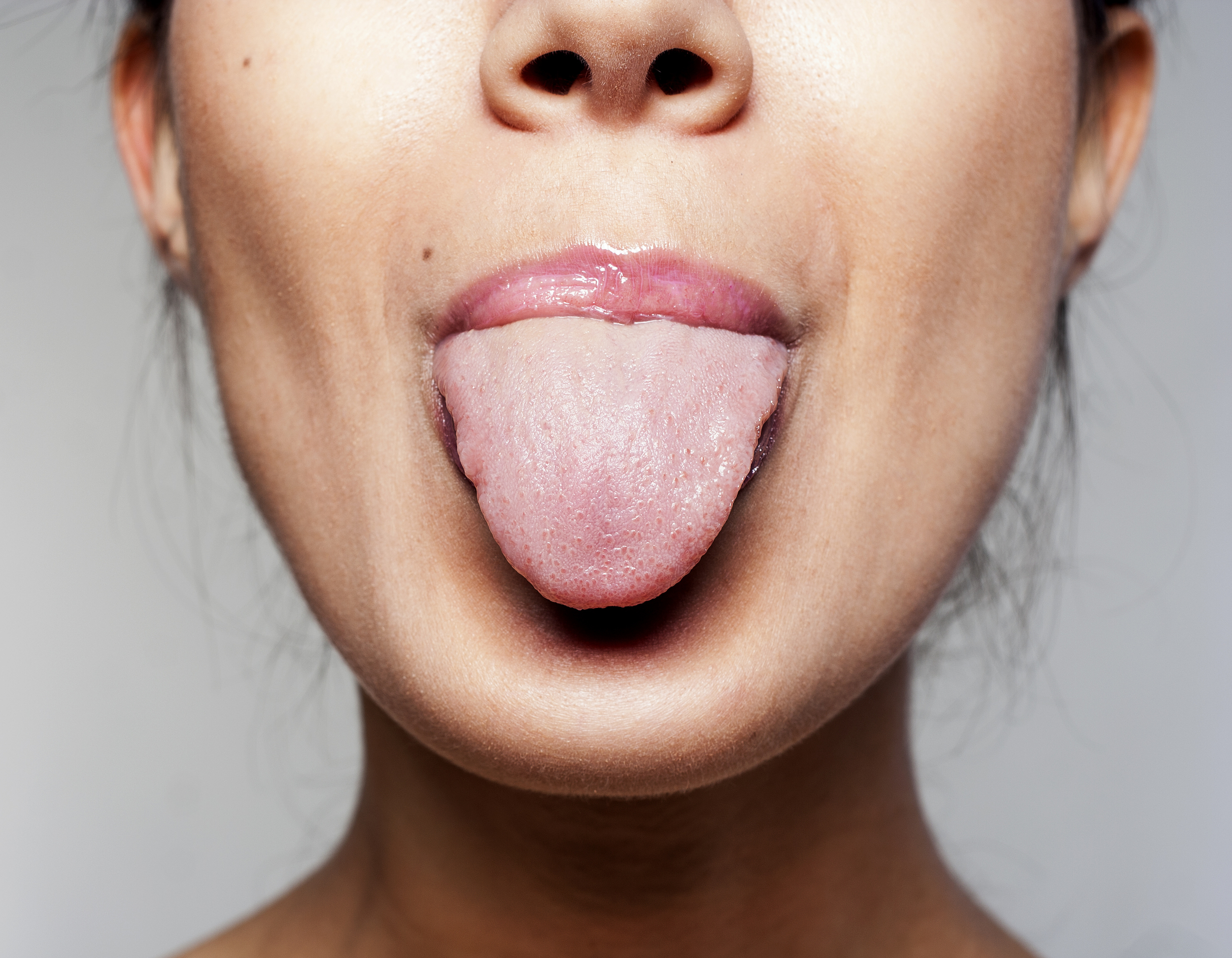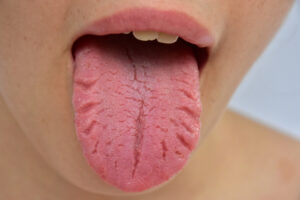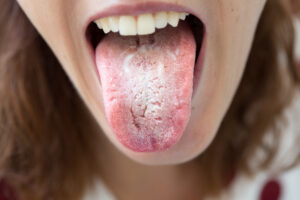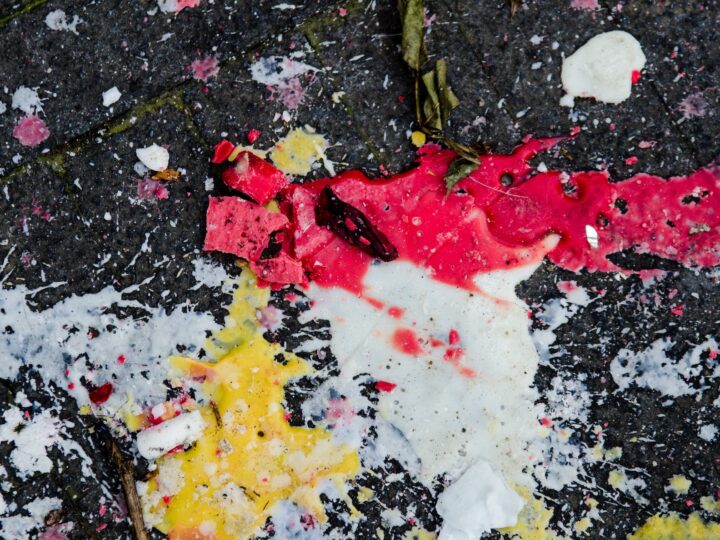WHAT YOUR TONGUE SAYS ABOUT YOU
Traditional Chinese Medicine & Your Tongue

Have you taken a good look at your tongue lately? Believe it or not, you can determine a lot about the state of your overall health just by taking a peek inside your mouth. Practitioners of Traditional Chinese Medicine (TCM) have used the tongue for hundreds of years as a roadmap to pinpoint specific health issues and determine an overall health diagnosis.
If you were to visit a TCM practitioner, they would examine your tongue, pulse, walk, and the way you talk through a series of questions. The result would be a prescribed combination of acupuncture or acupressure massage, herbal treatments, and nutritional and lifestyle adjustments to fix whatever ailments seem to be bothering you. All this from looking at your tongue!
So, Why Are We Looking at My Tongue?
For those unfamiliar with ancient Eastern medicine, examining the tongue may seem strange. After all, when was the last time you looked at someone’s tongue? In the practice of TCM, like Ayurveda, it is believed that the tongue provides visual cues as to what’s happening in the body’s key meridians (the pathways which energy moves throughout the body) and the major organs (ie., liver, lungs, spleen, heart, and kidneys). This is because the entire body is designed to work together in harmony, so an imbalance in one part will affect the others.
Elements to Check On Your Tongue
Ready to take a look? Open up and stick your tongue out. You’ll be looking at the color, shape, size, coating and texture.
Tongue Color
The colors of the tongue vary range from pale pink to dark purple. As most spectrums go, a healthy tongue should fall somewhere in the middle- in a light red shade. So, if you’d got the just-right shade, TCM would say you’ve got great vitality and strong qi (AKA energy).
While pale pink might be a trendy hue, lifeless-looking tongue colors might symbolize a low blood flow, energy, or poor digestion. A TCM practitioner might also evaluate health concerns involving the pancreas, stomach, or kidneys. In most cases, if your tongue is bright red it might mean that you’re dehydrated or deficient in one or more key vitamins and minerals like folic acid, iron, and vitamin B-12. There can be other, more serious causes like scarlet fever, so be sure to see your doctor with any serious concerns. A dark, purple-ish tongue can signify an issue with circulation or the quality of blood, which makes logical sense given thick blood doesn’t flow so easily and tends to be darker in color. People suffering from issues related to endometriosis, polycystic ovaries, migraines, or arthritis have been known to have deeper hued tongues, so if you see a color fit for a royal throne, you may want to get a checkup.
Shape and Size
 This tongue characteristic covers a few areas including the overall size or width, the shape of the outer edges, and any cracks, bumps or patterns on the tongue. Most healthy tongues are an appropriate size for the mouth, not obstructive to the teeth but large enough to aid in eating and speaking. They tend to be smooth and flat and rounded on the edges, with no cracks, bumps or unusual shapes.
This tongue characteristic covers a few areas including the overall size or width, the shape of the outer edges, and any cracks, bumps or patterns on the tongue. Most healthy tongues are an appropriate size for the mouth, not obstructive to the teeth but large enough to aid in eating and speaking. They tend to be smooth and flat and rounded on the edges, with no cracks, bumps or unusual shapes.
There are many signs of unhealthy sizes and shapes of the tongue. If it’s larger than normal and curved and indented along the edges to resemble the teeth, it’s a sign of exhaustion as extremely tired and stressed people tend to thrust their tongue onto the backs of the teeth. If you’ve ever been to a yoga class and heard the instructor say, “Now remove your tongue from the roof of your mouth,” you likely didn’t even realize you were doing it until they said so. This natural reaction of the tongue occurs when people are in uncomfortable spots both mentally and physically. Issues with the thyroid, pancreas, or a chronic fatigue condition have also been said to show similar effects on the tongue.
If you notice deep indents and cracks located in the central part of the tongue, it might mean there are long-term digestive or heart issues occurring that need to be treated. While that may sound like a bit of a stretch, take a minute to think about it. What level of physical distress would it take to cause a large crack in your tongue? Probably something pretty intense. If this sounds like you, you may want to check in with your doctor.
Dry cracks all over the tongue, however, probably indicate a general lack of hydration. Unhealthy weight gain or loss can also change the look of your tongue, much like it does to the skin under your arms. Those who are overweight are more likely to have wide, moist tongues that are light in color. Underweight people will probably have thin, red tongues.
Coating and Texture
 A healthy coating and texture for tongues generally is a very thin white layer of coating. This coating may become more dense or slightly yellow in color in the far back area as bacteria tends to pool in these spots. The texture of your tongue should be fairly smooth, without major changes across the surface or edges.
A healthy coating and texture for tongues generally is a very thin white layer of coating. This coating may become more dense or slightly yellow in color in the far back area as bacteria tends to pool in these spots. The texture of your tongue should be fairly smooth, without major changes across the surface or edges.
If the tongue is very dry, you should increase your water intake as this signals dehydration and may also coincide with insomnia, depression, anxiety, hyperactive thyroid, or high blood pressure. An overly slick, greasy, or yellow-looking can signify issues with your diet and digestion. So, if you’ve been eating one too many Shake Shack burgers, you won’t only feel gross, your tongue will also tell that story to someone who takes a look.
Unusual textures and coatings on the tongue might be the most alarming signs of health concerns. There are a few common coatings to be aware of. The first is a thicker white coating, appearing either in patches or all over the tongue. Sometimes known as thrush, it could be caused by the yeast candida, which is a fungal infection often treated with an antifungal pill. A hair-like black tongue coating can signal poor hygiene, diabetes, yeast infection, or poor reactions to cancer treatments. Oh, and you should know that Pepto Bismol and certain antibiotics can cause your tongue to turn black, so if you’ve been eating too much of that Shake Shack again and had to drink a little PB, don’t worry if you see a little black on your tongue or in your stool.
Tips for Maintaining a Healthy Tongue
Want to make sure your tongue shows normal, healthy signs next time you check in? The best way to maintain a healthy tongue, is to maintain a lifestyle and diet built around whole health wellness. Of course, we don’t expect you to be a saint all the time, but try to select vitamin and nutrient-rich foods with a balance of meats, fruits, vegetables, and grains. It’s also vital to keep the body well-hydrated, so keep that Hydroflask handy. Regular exercise, and time spent rebalancing the energy through meditation and rest are other good habits to incorporate.
For tongue-specific tips, be sure you’re keeping to a consistent and thorough dental hygiene practice. Yes, we’ll reiterate what you likely already know, but brush your teeth and tongue twice daily, don’t forget to floss, and visit your dentist for those deep cleanings twice per year. If you’re concerned by what you see on your tongue, check in with a TCM practitioner for a full, expert examination and treatment plan.
Comments (0)
Leave a reply
You must be logged in to post a comment.




